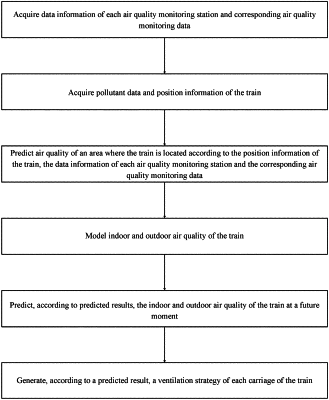| CPC B60H 1/0073 (2019.05) [B60H 1/008 (2013.01); B60H 1/00828 (2013.01); B60H 3/0085 (2013.01); B61D 27/009 (2013.01); B60Y 2200/30 (2013.01)] | 8 Claims |

|
1. A health protection method for passengers on a train in a polluted indoor environment, which is implemented by a health protection system for the passengers on the train in the polluted indoor environment, wherein the health protection system comprises: a basic data acquisition circuit, an outdoor air quality prediction circuit, an indoor air quality prediction circuit and a ventilation strategy generation circuit; wherein an output end of the basic data acquisition circuit is connected with an input end of the outdoor air quality prediction circuit and an input end of the indoor air quality prediction circuit simultaneously; an output end of the outdoor air quality prediction circuit and an output end of the indoor air quality prediction circuit are both connected with the ventilation strategy generation circuit; the basic data acquisition circuit is configured to acquire air quality data and position information of an air quality monitoring station and indoor and outdoor pollutant data information of the train; the outdoor air quality prediction circuit is configured to predict outdoor air quality data of the train; the indoor air quality prediction circuit is configured to predict indoor air quality data of the train; and the ventilation strategy generation circuit is configured to generate a ventilation strategy according to indoor and outdoor air quality prediction data of the train, thereby achieving health protection of the passengers on the train; wherein, the health protection method comprises the following steps:
S1. acquire data information of each air quality monitoring station and corresponding air quality monitoring data;
S2. acquire pollutant data information and position information of the train;
S3. predict an air quality of an area where the train is located according to the position information of the train, the data information of the each air quality monitoring station and the corresponding air quality monitoring data; specifically, it is to predict the air quality in the following steps:
A. calculate a historical distance between the train and the each air quality monitoring station according to the position information of the train at t historical moments and position information of the each air quality monitoring station;
B. calculate a predicted position of the train after future T minutes by using the following equation:
LOCTC=[LOTC+T×v×rLOT,LATC+T×v×rLAT]
wherein, LOCTC is the predicted position of the train after the future T minutes, LOTC is longitude information of a current position of the train, v is an average speed per minute of the train in past minutes, rLOT is longitude component data of a directed path of a remaining running route of the train, LATC is latitude information of the current position of the train, and rLAT is latitude component data of the directed path of the remaining running route of the train;
C. calculate a predicted distance between the train and the each air quality monitoring station after the T minutes;
D. calculate a real-time distance between the train and the each air quality monitoring station, select a plurality of air quality monitoring stations with a least real-time distance as a minimum space unit of an area passed by the train, and record air quality monitoring data corresponding to the plurality of selected air quality monitoring stations;
E. record historical distances between the plurality of selected air quality monitoring stations in the step D and the train, and establish a pollutant diffusion model in the minimum space unit; specifically, it is to use a weighted regularization extreme learning machine as the pollutant diffusion model in the minimum space unit; an input of the model is a distance between the train at each historical moment and the each air quality monitoring station, and the air quality monitoring data corresponding to the each air quality monitoring station; and an output of the model is pollutant data information of a position where the train is located at each historical moment; and
F. predict the air quality of the area where the train is located after the T minutes according to the pollutant diffusion model in the minimum space unit obtained in the step E and the predicted distance between the train and the each air quality monitoring station after the T minutes obtained in the step C;
S4. model an indoor and outdoor air quality of the train;
S5. predict, according to predicted results of the steps S3 and S4, the indoor and outdoor air quality of the train at a future moment; and
S6. generate, according to a predicted result of the step S5, a ventilation strategy of each carriage of the train.
|